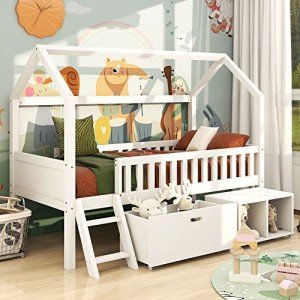A Comprehensive Guide to Children's Bunk Beds: Styles, Benefits, and Safety Considerations
Bunk beds have ended up being a popular choice for households looking to optimize space and offer an enjoyable sleeping environment for children. With their distinct style, they offer an imaginative and useful option for shared bedrooms, playrooms, or even guest lodging. This article explores the different designs of kids's bunk beds, their benefits, security factors to consider, and responds to some frequently asked questions.
The Allure of Bunk Beds
Children's bunk beds are more than just space-saving structures; they are also an entrance to daring dreams and creative play. Below is a comprehensive examination of their various advantages.
Benefits of Bunk Beds
- Space-Saving: Bunk beds efficiently use vertical space, making them an ideal choice for smaller rooms.
- Lively Design: Many bunk bed styles consist of slides, tents, and themed components, triggering creativity and excitement.
- Partner Sharing: Bunk beds are best for brother or sisters sharing a space or accommodating pajama parties.
- Flexible Use: Some designs can be separated into two individual beds, providing flexibility as children grow.
- Storage Options: Many bunk beds feature integrated drawer storage or shelves, further boosting their usefulness.
Designs of Children's Bunk Beds
The variety of bunk beds available today accommodates different preferences and needs. Below is a summary of some popular designs.
| Style | Description | Best For |
|---|---|---|
| Requirement Bunk Bed | A traditional design featuring one bed stacked above another. | Siblings sharing a room. |
| Loft Bed | Comparable to a bunk bed without the bottom bunk, enables for a workspace or play area listed below. | Limited space for play/desk. |
| L-Shaped Bunk Bed | Two beds organized in an L-shape, often with extra areas for storage or play. | Unique room layouts. |
| Twin Over Full | A twin bed over a complete bed, accommodating various sleep requirements. | Growing children and teens. |
| High Sleeper | Stands even higher than a loft bed, usually featuring a desk or play area below. | Older kids requiring more play/desk space. |
| Camping Tent Bunk Bed | Bunk beds with a canopy or tent-like structure, producing a comfortable, fun space. | Active and imaginative children. |
Secret Features to Consider
When selecting the best bunk bed for kids, the following features deserve considering:
- Material: Bunk beds can be made from wood, metal, or a mix. Each has its special aesthetic and resilience.
- Weight Capacity: Always validate the weight limit of the bunk bed to ensure it can accommodate your children securely.
- Safety Rails: Ensure the leading bunk has durable rails to avoid falls.
- Ladder Security: A properly designed ladder needs to use simple and safe access to the upper bunk.
- Finishing: Ensure any surfaces are non-toxic and safe for children.
Security Considerations
Security is critical when it pertains to children's bunk beds. The following standards must be abided by:
- Age Appropriateness: Generally, children under 6 years of ages need to not oversleep the upper bunk due to security dangers.
- Sturdy Construction: Ensure the frame and products are solid and can support the weight without drooping.
- Regular Maintenance: Periodically look for loose screws, bolts, or other components that may require tightening.
- Clear Play Area: Keep the location around the bunk bed devoid of toys and barriers to reduce tripping risks.
Setting Rules for Safe Use
Establishing guidelines for bunk bed usage will help ensure safety:
- Limit Jumping and Climbing: Children ought to be advised versus leaping from the leading bunk and getting on the sides.
- Monitoring Sleepovers: Monitor young guests while they are using the bunk bed for the first time.
- Inform on Ladder Use: Teach how to use the ladder safely, emphasizing the value of facing the ladder when going up or down.
Frequently Asked Questions
1. What age is proper for a child to sleep in the top bunk?
Most makers recommend that kids need to be at least 6 years old to sleep in the upper bunk. This guideline is developed to reduce the danger of falls.
2. Can bunk beds be customized?
Yes, many manufacturers provide customizable alternatives, consisting of colors, products, and additional features like drawers or desks.
3. Are bunk beds safe for weight?
Bunk beds have weight limits, typically varying from 200 to 400 pounds, depending on the model and product. Constantly examine the maker's specifications.
4. How do I maintain and clean up a bunk bed?
Routinely look for loose parts, keep the bed tidy by cleaning down surface areas, and guarantee the bedding is fresh to promote a safe and hygienic sleep environment.
5. Can bunk beds be separated into private beds?
Many bunk beds come with an alternative to separate them into 2 private beds, supplying long-lasting adaptability.
Children's bunk beds are more than simple furnishings; they are a functional, versatile, and creative component of a child's room. With numerous styles available and numerous safety factors to consider to bear in mind, parents can choose the ideal bed that fits their space, satisfies their kids's needs, and instills a sense of experience. By comprehending the benefits, designs, and precaution related to bunk beds, households can develop a wonderful and protected sleeping environment for their kids. Whether for Bunks or sisters sharing a space or space-saving options, bunk beds stay a cherished choice for many homes.

